Ijraset Journal For Research in Applied Science and Engineering Technology
- Home / Ijraset
- On This Page
- Abstract
- Introduction
- Conclusion
- References
- Copyright
Analysis of Ergonomic Designed Healthcare Bed for Lateral Tilting and Rotation
Authors: S D Mohan Karthik, Dr. N. Nandakumar, Dr. S. Periyasamy
DOI Link: https://doi.org/10.22214/ijraset.2024.63053
Certificate: View Certificate
Abstract
This project revolves around the analysis of a novel healthcare bed designed to address the needs of patients with limited mobility, offering lateral tilting and rotation capabilities, which is crucial for their comfort, recovery, and healthcare providers\' efficiency. The primary aim of this project is to create a healthcare bed that improves patient mobility through lateral tilting and rotation mechanisms. By utilizing engineering solutions, we intend to design a healthcare bed that reduce the physical strain on healthcare providers during patient handling. The project begins with a comprehensive literature review of existing hospital bed designs and relevant medical guidelines. It progresses to the conceptualization of the bed, considering the specific requirements of patients and healthcare professionals. Healthcare bed, with detailed technical specifications is made using solidworks premium 2019 SP5.0 software which is later analysed using ansys 2020 R1 software
Introduction
I. INTRODUCTION
T A healthcare bed, also known as a hospital bed, is a specialized bed designed for use in healthcare settings to provide comfort, support, and medical care for patients. These beds are equipped with various features to accommodate the unique needs of individuals receiving medical treatment, recovering from illness or surgery, or dealing with chronic conditions. Healthcare beds play a crucial role in patient care and contribute to the overall wellbeing and comfort of individuals receiving medical treatment in hospitals, clinics, and other healthcare facilities. Their design and features are tailored to address the specific needs of patients and healthcare providers.
A. Challenges And Benefits
Advanced healthcare beds with sophisticated features can be expensive, posing financial challenges for healthcare facilities, especially in resource-constrained settings. Regular maintenance and occasional repairs are necessary for healthcare beds to ensure optimal functionality. This can be time-consuming and may lead to temporary bed unavailability. Healthcare facilities often face space constraints, and accommodating specialized beds for various patient needs can be challenging. Healthcare professionals need proper training to operate and utilize the features of advanced healthcare beds effectively. Lack of training may lead to underutilization or misuse. 2 Maintaining cleanliness and infection control in and around healthcare beds is critical. The design complexity of certain beds can make thorough cleaning more challenging. Despite advancements, achieving the optimal balance between clinical functionality and patient comfort can be challenging. Patient comfort is crucial for recovery and well-being. Integrating healthcare beds with electronic health records (EHR) or other healthcare systems for seamless data flow can be a technical challenge that healthcare facilities may face.
B. Benefits
Healthcare beds enhance patient care by providing adjustable positions that cater to individual needs, contributing to comfort and well-being. Specialized mattresses and pressure-relieving features in healthcare beds help prevent pressure ulcers, a common concern for patients with limited mobility. Features like height adjustment and mobility assistance contribute to better patient mobility, facilitating activities like transfers and rehabilitation exercises. Side rails and adjustable bed heights contribute to patient safety, reducing the risk of falls and injuries. Healthcare beds come with various features that can be customized to meet specific patient requirements, ensuring personalized care. Some healthcare beds integrate with monitoring devices, providing healthcare professionals with real-time data for better patient management. Electric controls, remote capabilities, and CPR release functions enhance the efficiency of healthcare professionals in providing timely and effective care.
Healthcare beds cater to a wide range of medical needs, including bariatric care, maternity care, and specialized patient populations, contributing to versatile patient care. 3 Features like height adjustment reduce strain on caregivers, promoting a more comfortable and ergonomic caregiving environment.
C. Objective
The primary objective of this project is to conduct a comprehensive analysis of an ergonomically designed healthcare bed with lateral tilting and rotation capabilities. The focus will be on evaluating the bed's design, functionality, and impact on patient care and healthcare professional tasks.
D. Different Functions In Healthcare Bed
Adjustable Height: Allows the healthcare bed to be raised or lowered to a comfortable working height for healthcare professionals. It aids in patient transfer and caregiver access. Head and Foot Adjustment: Enables the adjustment of the head and foot sections of the bed independently. This feature is useful for patients who need to be in a semi[1]upright position or have their legs elevated. Trendelenburg and Reverse Trendelenburg Positions: Allows the bed to be inclined with the head lower than the feet (Trendelenburg) or vice versa (Reverse Trendelenburg). These positions are often used in surgical procedures or to address specific medical conditions. Side Rails: Provides safety by preventing patients from accidentally rolling out of bed. Side rails can be raised or lowered as needed. Mobility Wheels: Equips the bed with wheels for easy movement within healthcare facilities. Locking mechanisms ensure stability when needed. Pressure-Relieving Mattresses: Specialized mattresses designed to reduce pressure on specific areas of the body, helping to prevent pressure ulcers. 4 Remote Controls: Electrically adjustable beds often come with remote controls, allowing patients to adjust the bed's position without assistance. Weight Capacity Adjustment: Some healthcare beds, especially bariatric beds, allow adjustment of weight capacity to accommodate patients of different sizes. Integrated Scales: Measures and displays the patient's weight directly on the bed, eliminating the need for separate weighing scales. Cardiac Chair Position: Raises the head section and elevates the knees, creating a position similar to sitting in a recliner. This can be beneficial for patients recovering from cardiac surgery. Heating and Cooling Features: Some advanced healthcare beds come with integrated heating or cooling elements to enhance patient comfort. Entertainment and Connectivity: Includes features such as USB ports, power outlets, and integrated entertainment systems to enhance the patient's experience during extended stays.
E. Lateral Tilting And Rotation Capabilities In Healthcare Bed
Lateral tilting and rotation capabilities in healthcare beds are advanced features designed to enhance patient care and improve the working conditions for healthcare professionals. These capabilities provide additional flexibility in patient positioning, contributing to comfort, mobility, and various medical procedures..
II. PROBLEM IDENTIFICATION
Design Problems
Most of the typical healthcare bed only consist of horizontal movement which is used to rise the head leg of the patient so that patient’s vertical movement is done by the healthcare professions
III. DESIGN OF HEALTHCARE BED
A. Healthcare Bed
Healthcare bed design is a specialized field of product design focused on creating beds that cater to the unique needs of patients in healthcare settings, such as hospitals, clinics, long-term care facilities, and home care.
B. Design Process
Designing a healthcare bed involves a systematic and multidisciplinary design process to ensure that the bed meets the unique needs of patients and healthcare professionals. Project Definition and Research: Define the project goals, including the specific needs and requirements of the target users. Conduct extensive research to understand the challenges and opportunities in healthcare bed design. Consider input from healthcare professionals and patients. Concept Generation: Brainstorm and develop multiple conceptual designs. Consider factors such as adjustability, comfort, safety, and ease of use. Generate innovative ideas to address the identified needs. Preliminary Design: Select the most promising concepts and create preliminary designs.
These designs should include rough sketches, 2D drawings, or 3D models to visualize the bed's form and features. Detailed Design and Engineering: Refine the selected preliminary design based on engineering principles. Ensure that the bed meets safety standards, load-bearing requirements, and durability criteria. Develop detailed CAD (Computer-Aided Design) drawings and specifications. Ergonomic Evaluation: Perform ergonomic evaluations to assess how well the bed design aligns with ergonomic principles. This involves evaluating comfort, ease of use, and alignment with the human body's natural posture. Iterative Redesign: Based on user feedback and testing results, iterate on the design to address any identified issues or enhance the bed's features. This may involve several redesign cycles. 19 Materials and Manufacturing Selection: Finalize the choice of materials, production methods, and manufacturing partners for the bed. Consider factors such as material durability, ease of cleaning, and sustainability. Safety and Regulatory Compliance: Ensure that the bed design complies with safety and regulatory standards relevant to healthcare equipment, such as those set by healthcare authorities and standards organizations. The design process for a healthcare bed should prioritize patient comfort, safety, and ease of use while meeting the practical needs of healthcare professionals. Collaboration with healthcare experts and end-users is crucial to ensure that the final product aligns with real-world requirements.
IV. MECHANISM USED WEDGE CAM MECHANISM
A wedge cam mechanism, also known as a wedge cam system, is a type of mechanical linkage that converts rotary motion into linear motion. It consists of a cam and a follower. The unique feature of a wedge cam is its non-circular shape, which results in controlled linear movement of the follower as the cam rotates.
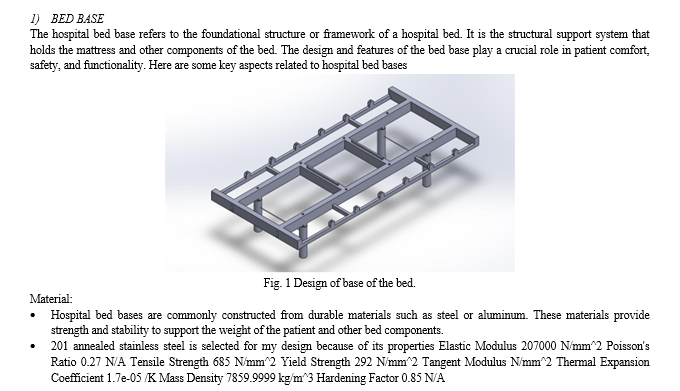
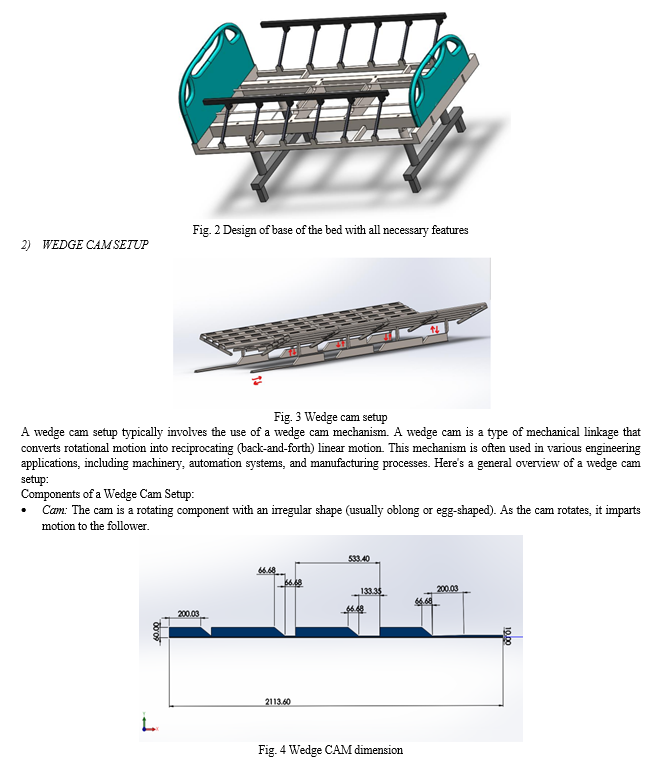
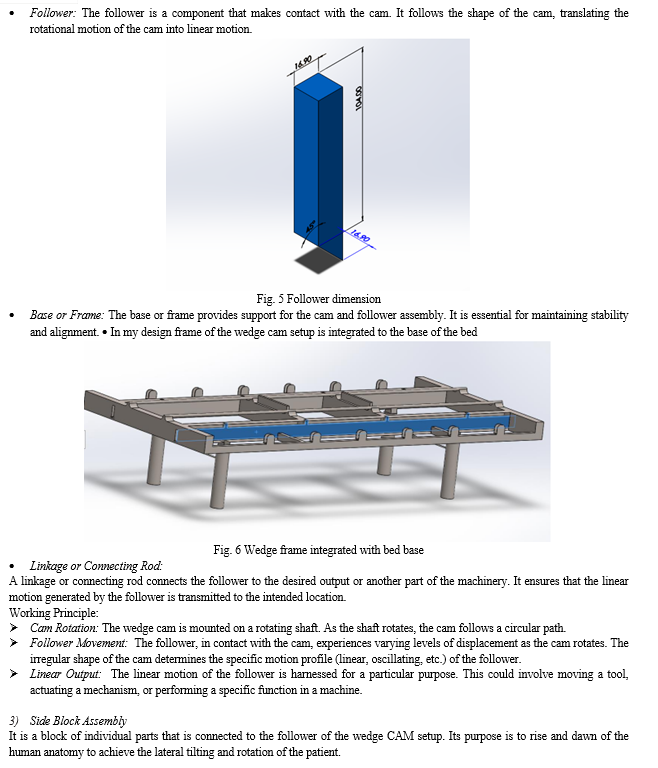
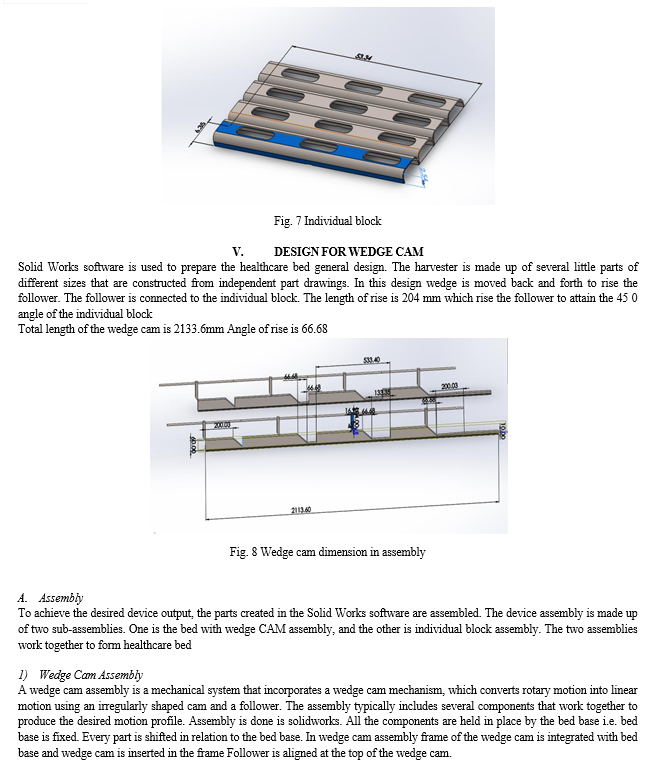

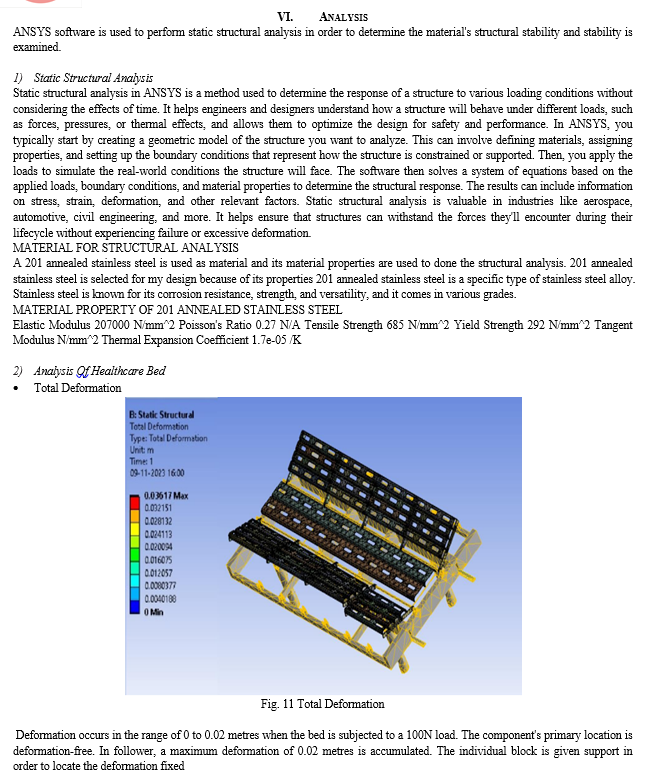
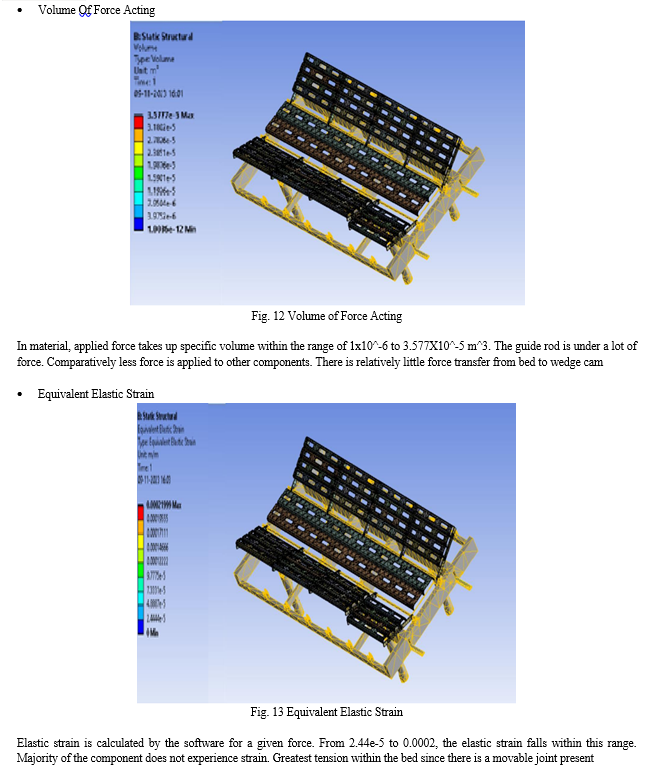
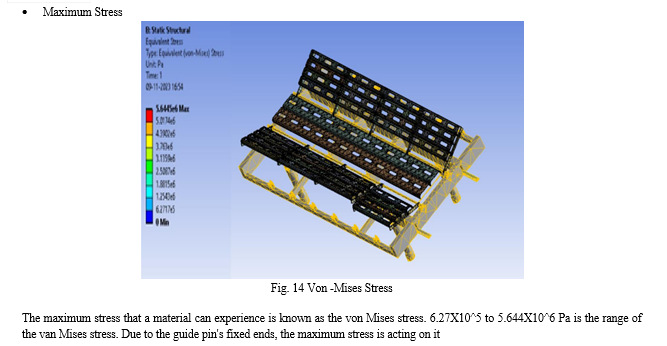
Conclusion
An ergonomic healthcare bed has been designed and thoroughly analyzed to successfully address the problem of healthcare professions need to lateral tilting and rotation of the patients. The apparatus is designed to lateral tilt and rotation of the patients without the direct involvement of healthcare professions. The size of the bed is fixed as standard 2133mm in length. Bed included with side guard to protect the patients from falling down while tilting and rotation. The bed is composed of stainless steel material whose density is 7.9 g/cm³. The device\'s feasibility for physical dvelopment are determined by analysing the device\'s results. The von Mises stress, which ranges from 6.27X10^5 to 5.644X10^6 Pa for a given force of 100N, is the highest stress that a material can withstand.This range of 2.44e-5 to 0.0002 is where the elastic strain is found. The majority of the part is not under stress. When a 100N load is applied to the bed, deformation takes place in the range of 0 to 0.02 metres which is negligible. The primary location of the component is free from deformation. A maximum of 0.02 metres of deformation can accumulate in follower. Within the range of 1x10^-6 to 3.577X10^-5 m^3, force occupies a specific volume. The above values are calculated based on the fixed support that is given to individual block
References
[1] Mohammeda, M. N., et al. \"A new design of multi-functional portable patient bed.\" Jurnal Teknologi (Sciences & Engineering) 58 (2012): 61-66. [2] Mohammeda, M. N., Khrita, N. G., Abdelgneia, M. A., Abubakera, E., Muftaha, A. F., Omara, M. Z., & Salleha, M. S. (2012). A new design of multi-functional portable patient bed. Jurnal Teknologi (Sciences & Engineering), 58, 61-66. [3] Mohammeda, M. N., N. G. Khrita, M. A. Abdelgneia, Es Abubakera, A. F. Muftaha, M. Z. Omara, and M. S. Salleha. \"A new design of multi-functional portable patient bed.\" Jurnal Teknologi (Sciences & Engineering) 58 (2012): 61-66. [4] Mohammeda, M.N., Khrita, N.G., Abdelgneia, M.A., Abubakera, E., Muftaha, A.F., Omara, M.Z. and Salleha, M.S., 2012. A new design of multi-functional portable patient bed. Jurnal Teknologi (Sciences & Engineering), 58, pp.61-66. [5] Mohammeda MN, Khrita NG, Abdelgneia MA, Abubakera E, Muftaha AF, Omara MZ, Salleha MS. A new design of multi-functional portable patient bed. Jurnal Teknologi (Sciences & Engineering). 2012 Oct; 58:61-6 [6] Abdallah¹, Omar Adel Mustafa, K. M. Abubacker, and V. Suresh Babu. \"Design and Analysis of Pneumatic Operated Bed for Hospitals.\" International Journal of Industrial Engineering 3.10 (2019): 102-109. [7] Abdallah¹, O. A. M., Abubacker, K. M., & Babu, V. S. (2019). Design and Analysis of Pneumatic Operated Bed for Hospitals. International Journal of Industrial Engineering, 3(10), 102-109. [8] Abdallah¹, Omar Adel Mustafa, K. M. Abubacker, and V. Suresh Babu. \"Design and Analysis of Pneumatic Operated Bed for Hospitals.\" International Journal of Industrial Engineering 3, no. 10 (2019): 102-109. [9] Abdallah¹, O.A.M., Abubacker, K.M. and Babu, V.S., 2019. Design and Analysis of Pneumatic Operated Bed for Hospitals. International Journal of Industrial Engineering, 3(10), pp.102-109. [10] Abdallah¹ OA, Abubacker KM, Babu VS. Design and Analysis of Pneumatic Operated Bed for Hospitals. International Journal of Industrial Engineering. 2019; 3(10):102-9 [11] He, Lu, et al. \"A systematic review of research design and modeling techniques in inpatient bed management.\" Computers & Industrial Engineering 127 (2019): 451-466. [12] He, L., Madathil, S. C., Oberoi, A., Servis, G., & Khasawneh, M. T. (2019). A systematic review of research design and modeling techniques in inpatient bed management. Computers & Industrial Engineering, 127, 451-466. [13] He, Lu, Sreenath Chalil Madathil, Amrita Oberoi, Greg Servis, and Mohammad T. Khasawneh. \"A systematic review of research design and modeling techniques in inpatient bed management.\" Computers & Industrial Engineering 127 (2019): 451-466. [14] He, L., Madathil, S.C., Oberoi, A., Servis, G. and Khasawneh, M.T., 2019. A systematic review of research design and modeling techniques in inpatient bed management. Computers & Industrial Engineering, 127, pp.451-466. [15] He L, Madathil SC, Oberoi A, Servis G, Khasawneh MT. A systematic review of research design and modeling techniques in inpatient bed management. Computers & Industrial Engineering. 2019 Jan 1; 127:451-66. [16] Helm, Jonathan E., Shervin AhmadBeygi, and Mark P. Van Oyen. \"Design and analysis of hospital admission control for operational effectiveness.\" Production and Operations Management 20.3 (2011): 359-374. [17] Helm, J. E., AhmadBeygi, S., & Van Oyen, M. P. (2011). Design and analysis of hospital admission control for operational effectiveness. Production and Operations Management, 20(3), 359-374. [18] Helm, Jonathan E., Shervin AhmadBeygi, and Mark P. Van Oyen. \"Design and analysis of hospital admission control for operational effectiveness.\" Production and Operations Management 20, no. 3 (2011): 359-374. [19] Helm, J.E., AhmadBeygi, S. and Van Oyen, M.P., 2011. Design and analysis of hospital admission control for operational effectiveness. Production and Operations Management, 20(3), pp.359-374. [20] Helm JE, AhmadBeygi S, Van Oyen MP. Design and analysis of hospital admission control for operational effectiveness. Production and Operations Management. 2011 May; 20(3):359-74
Copyright
Copyright © 2024 S D Mohan Karthik, Dr. N. Nandakumar, Dr. S. Periyasamy. This is an open access article distributed under the Creative Commons Attribution License, which permits unrestricted use, distribution, and reproduction in any medium, provided the original work is properly cited.

Download Paper
Paper Id : IJRASET63053
Publish Date : 2024-06-01
ISSN : 2321-9653
Publisher Name : IJRASET
DOI Link : Click Here
 Submit Paper Online
Submit Paper Online

